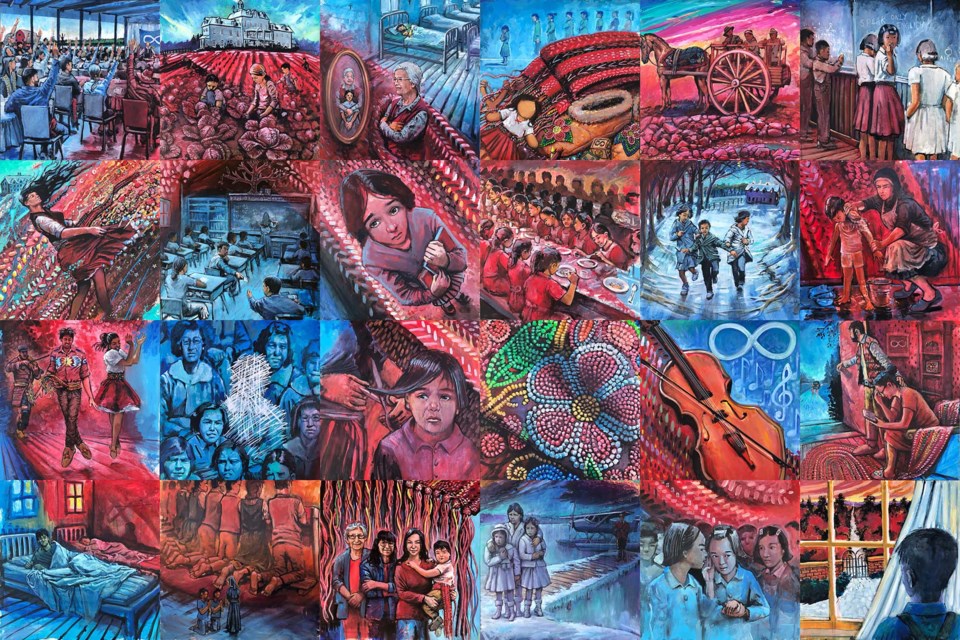Like many Canadians, St. Albert’s Billie-Jo Grant said she was devastated last year when hundreds of children were found buried in unmarked graves at a residential school in B.C. — a discovery that forced Canada to take a renewed look at its past abuse of Indigenous youths.
But unlike most Canadians, Grant had a plan in place to build on this revelation — one that would strengthen people’s knowledge of Canada’s Métis people.
Grant and the Rupertsland Institute launched the Métis Memories project Nov. 17 as part of Métis Week. The free online mural project uses accounts from real Métis survivors to help Canadians understand the truth of Canada’s residential schools.
Grant said this project was done in partnership with St. Albert-area artist Lewis Lavoie and had been in the works for about two years before last year’s discovery.
Lisa Cruickshank, who works on Métis education with Grant at the Rupertsland Institute, said this project aims to teach youths about the Métis and their experience in residential schools. Much of it is based on first-hand accounts from school survivors written in the book Métis Memories of Residential Schools, which has been republished digitally for free as part of this project.
Grant said the team worked with Métis elder Angie Crerar (one of the two Métis Nation delegates set to speak with Pope Francis about residential schools later this year) to pick topics and stories from the book to illustrate.
Lavoie said he painted 24 two-by-two-foot tiles for the mural using a red and blue colour pallet. Each tile is linked to a specific theme or account from Métis Memories and shows various scenes from residential school life as well as cultural icons such as flower beadwork and a Red River cart. Viewed collectively, the tiles depicted a red infinity symbol on a blue background — a reference to the two flags of the Métis Nation.
Challenging images
Lavoie said it was challenging for him to create paintings about residential schools, as it was tough to find the beauty in such a horrible subject.
“For me the key word [the project team] gave me was ‘resilience,’” he said, a theme he tried to incorporate into each of the tiles.
For example, Tile 22 shows three grim-faced girls on a pier, at the end of which is a Mountie and a seaplane in shadow. Lavoie said this depicts Crerar’s account of how the RCMP came to take her and her sisters away to residential school.
“They never got to see their mother again because their mother ended up dying while they were in school,” Lavoie said.
Lavoie said he painted Crerar and her sisters to look scared, but also had Crerar wrap her arms around her siblings to show her determination to protect them.
The adjacent tile shows Crerar as she is today along with her daughter, granddaughter, and great-grandchild. Lavoie said he originally planned to show them all looking tough, but Crerar insisted they be smiling.
Grant said the mural gives teachers a safe way to introduce students to residential schools and Métis culture.
Tile 10, for example, depicts Métis students in a crowded residential school cafeteria and references the often-terrible quality of the food fed to students. Grant said teachers can start a discussion on this topic by asking students how they would feel if they had to eat the same thing every day, and later segue into a look at how experiments on Indigenous children helped shape Canada’s Food Guide.
Grant said she is now working on additional teacher resources to go with the mural as well as a portable version that could tour Alberta. She hopes Canadians will use this project to learn more about the Métis.
“The more I know about our history, the kinder I can look at my family and others. It just provides understanding.”
Lavoie said the mural’s tiles are currently in his studio and will eventually be assembled into a 6’-by-14’ mosaic at Métis Crossing in Smoky Lake.
The mural can be viewed at www.muralmosaic.com/metis-memories.




